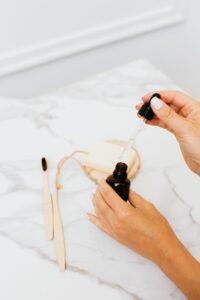Tips for Achieving Maximum Hydration

The art of body oil application is a vital step in achieving maximum hydration for your skin. Using the right techniques and products can help you maintain healthy and glowing skin throughout the year. Here are some tips to help you master the art of body oil application:
1. Choose the Right Oil for Your Skin Type
The first step to achieving maximum hydration is selecting the right oil for your skin type. If you have acne-prone or oily skin, you may want to opt for lighter oils like jojoba or grapeseed oil. If you have mature or dry skin, you may want to go for heavier oils like avocado or coconut oil. It’s important to read the label and make sure the oil is 100% pure and natural.
2. Exfoliate Your Skin Before Applying Body Oil
Before applying body oil, it’s essential to exfoliate your skin. Exfoliating helps to remove dead skin cells, allowing the oil to penetrate deeper into your skin. You can use a body scrub or dry brush to exfoliate your skin. Dry brushing is an excellent way to exfoliate and boost circulation. It’s also gentle enough for sensitive skin.
3. Apply Body Oil After a Shower
The best time to apply body oil is after a shower when your skin is still damp. Applying oil to damp skin helps to lock in moisture and leaves your skin feeling soft and supple. Pat your skin dry with a towel, leaving some moisture on your skin, and then apply the body oil all over your body.
4. Warm up the Oil Before Applying It to Your Skin
Body oils can be thick and cold, making it challenging to apply to your skin. To make it easier, warm up the oil in your hands before applying it to your skin. Rub your hands together to warm up the oil and then apply it to your body. Warming up the oil helps it to absorb into your skin more quickly.
5. Use Circular Motions When Applying Body Oil
When applying body oil, use circular motions to massage it into your skin. This technique helps to improve circulation and helps the oil penetrate deeper into your skin. Start at your ankles and work your way up your legs, then your arms, and finish with your torso. Don’t forget to apply oil to your hands and feet, which can easily become dry.
6. Don’t Forget to Apply Body Oil to Your Face
Body oils can also be used on your face, but make sure you choose an oil that’s suitable for facial use. Apply a small amount of oil to your face, using gentle circular motions. Body oils can help to balance your skin’s oil production and leave your skin looking radiant.
7. Use Body Oil as a Massage Oil
Body oils can also be used as massage oil. They can help to relax your muscles and leave your skin feeling soft and supple. Apply the oil to your hands, warm it up, and then massage it into your skin using circular motions. If you don’t have anyone to give you a massage, you can use a foam roller or massage ball to massage your muscles.
8. Apply Body Oil Before Bed
Applying body oil before bed can help to improve your skin’s hydration levels overnight. It’s also a great way to wind down and relax after a long day. Apply the oil to your skin using circular motions, and then climb into bed and let the oil work its magic.
In conclusion, the art of body oil application is a simple yet effective way to achieve maximum hydration for your skin, for both dry skin and oily skin. With the right techniques and products, you can maintain healthy and glowing skin throughout the year. Remember to choose the right oil for your skin type, exfoliate your skin before applying body oil, warm up the oil before applying it to your skin, use circular motions when applying body oil, don’t forget to apply body oil to your face, use body oil as a massage oil, and apply body oil before bed for maximum hydration.

